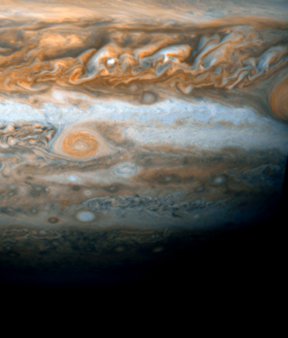|
News Notes
Planetary geology
Jupiter's junior red spot
 Jupiter’s
famed Great Red Spot has a new companion. The recent addition, nicknamed
“Red Spot Jr.” by scientists, is now one of only two red spots
on the planet. Red Spot Jr. started out white, like almost all of Jupiter’s
“spots,” which are actually storms similar to cyclones on Earth.
The storm has been there for decades, says Amy Simon-Miller, a planetary
scientist at NASA Goddard Space Flight Center in Greenbelt, Md. Beginning
sometime in January, however, the spot turned from white to red, “the
first time we have ever seen that happen,” Simon-Miller says.
Jupiter’s
famed Great Red Spot has a new companion. The recent addition, nicknamed
“Red Spot Jr.” by scientists, is now one of only two red spots
on the planet. Red Spot Jr. started out white, like almost all of Jupiter’s
“spots,” which are actually storms similar to cyclones on Earth.
The storm has been there for decades, says Amy Simon-Miller, a planetary
scientist at NASA Goddard Space Flight Center in Greenbelt, Md. Beginning
sometime in January, however, the spot turned from white to red, “the
first time we have ever seen that happen,” Simon-Miller says.
First noticed by amateur astronomers with ground-based telescopes, the color change was confirmed by Simon-Miller and colleagues in detailed images (one of which is shown in the image to the right) captured April 8 and April 16 by NASA’s Hubble Space Telescope. As to why the change occurred, “we’re not sure,” Simon-Miller says. One possibility is that the measured increases in Red Spot Jr.’s wind speeds are dredging up different material from deeper in Jupiter’s atmosphere, which appears red when hit by ultraviolet light from the sun.
To get more data for the models, Simon-Miller and colleagues plan to
use the Hubble telescope to collect more temperature and wind speed data.
Specifically, they will watch the wind interactions as Red Spot Jr. passes
below the Great Red Spot this month. “That’s when things are
likely to happen if they’re going to,” she says, including the
possibility that Red Spot Jr. will weaken and revert back to its previous
bland, white appearance.
Kathryn Hansen

 Subscribe
Subscribe

